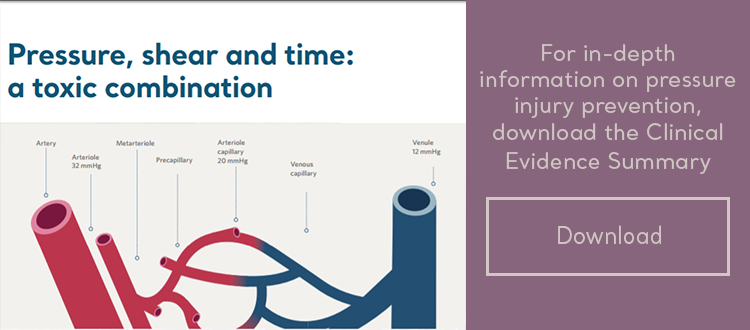The negative effects of excessive moisture at the skin are well known. Excessive moisture weakens the linkages between the collagen fibres in the dermis and softens the stratum corneum, leading to the skin becoming macerated or “boggy”. This maceration increases the skin’s susceptibility to shear, friction and deformation, ultimately increasing the susceptibility to pressure injury formation.

Moisture-Associated Skin Damage has been introduced as an umbrella term to describe four distinct conditions whereby extended exposure of the skin to moisture leads to damage to the skin. These four conditions are: incontinence-associated dermatitis (IAD), intertriginous dermatitis (ITD), periwound moisture-associated dermatitis, and peristomal irritant contact dermatitis.1
Incontinence-Associated Dermatitis (IAD)
IAD describes erythema and inflammation of the skin, typically caused by exposure to excess urine and liquid stool. The inflammation is caused by the chemical irritation of the urine or liquid stool in contact with the skin.1
Intertriginous Dermatitis (ITD)
ITD is caused by excess perspiration becoming trapped between skin folds. This lack of air circulation between the skin folds leads to maceration of the skin, causing skin irritation and increased likelihood of pressure injury formation.1
Periwound Moisture-Associated Dermatitis
As part of the healing process, wounds will produce exudate during the inflammatory stage. Excessive wound exudate can cause the area in the immediate vicinity of the wound to become macerated and break down.1
Peristomal Moisture-Associated Dermatitis
Stoma pouches are fitted with skin barriers to keep the skin dry and prevent exposure to bacteria. However, excessive moisture can lead to the barrier becoming ineffective, exposing the underlying skin to urine or faecal effluent. This exposure can lead to “inflammation and erosion of the skin that begins at the stoma/skin junction and extends outward in a 10cm radius”.2
Moisture and Microclimate
By definition, microclimate is “local tissue temperature and moisture at the body/support surface interace”.3 Excessive moisture typically comes from three sources:
- Perspiration
- Incontinence
- Drainage
MASD is a direct relation to the above three causes of excessive moisture. Therefore, by managing microclimate we can impact upon the effects that excessive moisture has on the skin.
Microclimate Management
Any surface that is in contact with the skin has the potential to affect the microclimate.3 The overall effect is dependent on the nature of the support surface and the cover. There are numerous ways to normalise the local skin microclimate, the simplest being to reposition the patient. However, this is not always possible and many patients may require additional interventions. The International Pressure Ulcer Prevention and Management Guidelines3 discuss how managing microclimate can provide an environment conducive to injury prevention and tissue repair. As such the guidelines recommend the need for additional features such as the ability to control moisture and temperature when selecting a support surface.
The following can provide additional microclimate management:
Low Air Loss (LAL) Mattresses – Low air loss mattresses use positive air flow to manage the microclimate at the skin-surface interface. Room air is sucked in to the pump and circulated throughout the mattress where it leaks out at the surface. This provides a circulation of air at the skin-surface interface which may play a role in reducing surface temperature and moisture.
Microclimate Management Coverlet – The Skin IQ family of products are mattress coverlets that apply a unique Negative Airflow Technology (NAT) to draw temperature and moisture away from the skin-surface interface. The Skin IQ family of products have proven beneficial in normalising microclimate, reducing odour and promoting an environment conducive to healing.4,5,6,7
Please contact your local Arjo representative to find out which solution can be best tailored to your needs.
References
- Dowsett C, Allen L. (2013). Moisture-Associated Skin Damage Made Easy. Wounds UK. 9(4). Available from: https://www.wounds-uk.com/resources/details/moisture-associated-skin-damage-made-easy
- Colwell JC, Ratliff CR, Goldburg M. et al. (2009). MASD Part 3: Peristomal Moisture-Associated Dermatitis and Periwound Moisture-Associated Dermatitis: A Consensus. J Wound Ost Continence Nurs. 38(4):359-70.
- National Pressure Ulcer Advisory Panel, European Pressure Ulcer Advisory Panel and Pan Pacific Pressure Injury Alliance. Prevention and Treatment of Pressure Ulcers: Clinical Practice Guidelines. Emily Haesler (Ed.). Cambridge Media: Perth, Australia; 2014.
- Reger S, Ranganathan V, McNulty A. (2014). Use of a Powered Coverlet for Mositure Removal, Skin Temperature Reduction, Odour and Bacteria Control. J Wound Ostomy Continence Nursing. 41(1):35-39.
- Clark M, Lahmann N. (2017). Clinical Evaluation of the Skin IQ Microclimate Manager and Case Reports. Wounds International. 2011 (Suppl.):1-4. At: http://www.woundsinternational.com/media/issues/533/files/content10235.pdf Accesed: August 2017.
- Kohr R. (2011). Simple Solutions for Low Air Loss Needs: Evaluating a New Surface. Poster Presentation, 30th CAET National Conference, Montreal, Quebec, May 26th-29th.
- Collier M, Potts C, Shaw E. (2014). Use of a Coverlet System for the Management of Skin Microclimate. British Journal of Nursing (Tissue Viability Supplement). 23(15):S28-35.
